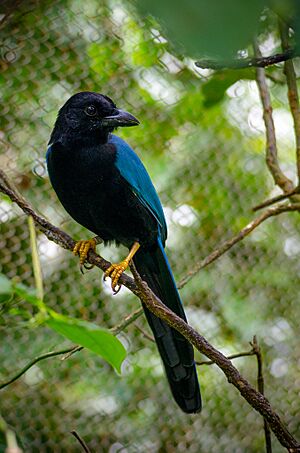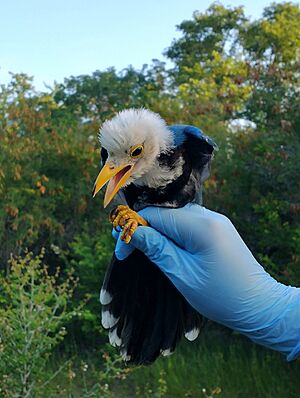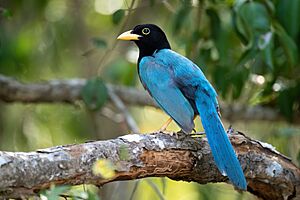Yucatan jay facts for kids
Quick facts for kids Yucatan jay |
|
|---|---|
 |
|
| Adult in Mexico | |
| Conservation status | |
| Scientific classification | |
| Genus: |
Cyanocorax
|
| Species: |
yucatanicus
|
 |
|
| Range (year-round) | |
The Yucatan jay (Cyanocorax yucatanicus) is a cool bird that belongs to the Corvidae family. This family includes crows and their relatives. You can find this bird living in the Yucatán Peninsula. It likes places like dry forests, farms, and open areas. It lives at heights up to 250 m (820 ft).
Adult Yucatan jays are about 30 cm (12 in) long. They have black bodies, bright blue wings, and blue tails. Their beaks are black, and they have yellow rings around their eyes and yellow legs. Young jays have yellow beaks. This type of jay is common and lives in a large area. Because of this, experts say it is a "least concern" bird, meaning it's not in danger.
Contents
About the Yucatan Jay's Name
A scientist named Alphonse Dubois first described the Yucatan jay in 1875. He gave it the scientific name Cyanocitta yucatanica. Later, it was moved to a different group called Cyanocorax. This group was created by a German zoologist named Friedrich Boie in 1826. So, its new scientific name became Cyanocorax yucatanicus.
Scientists have studied the Yucatan jay's family tree. A study in 2010 looked at its mitochondrial DNA. This study showed that the Yucatan jay is closely related to three other jays. These are the bushy-crested jay, the San Blas jay, and the purplish-backed jay. They all share similar looks.
The Yucatan jay has two types, called subspecies.
- C. yucataniucs yucatanicus: You can find this type in Yucatán, Quintana Roo, and Campeche in Mexico. It also lives in northern Guatemala and northern Belize.
- C. yucatanicus rivularis: This type lives in Tabasco and southwestern Campeche in Mexico. It is a bit bigger than the other type. Its blue upperparts (top parts) have a shiny, silvery look.
What the Yucatan Jay Looks Like
An adult Yucatan jay has a black head, nape (back of the neck), and underparts (belly). Its back, wings, and tail are a bright blue. It has black irises (the colored part of the eye), black rings around its eyes, a black beak, and yellow legs and feet. Male and female jays look the same.
How Yucatan Jays Change Their Feathers
Yucatan jays change their feathers, or plumage, several times as they grow. Young jays, called juveniles, have a white head, body, and tail tip. Their back is a soft blue, and their wings and tail are a soft grey. Their beak, legs, and feet are a soft yellow with a pink tint. The inside of their beak is white, and their eyes are dark brown.
These colors start to fade a few weeks after the young birds learn to fly, which is called fledging. At this time, their legs, feet, beak, and eye rings become more clearly yellow. They also start to replace their white head and body feathers with black ones.
During their first year, Yucatan jays have a completely black head and body. Their legs, feet, and eye rings stay yellow. The inside of their beak stays white but gets a slightly duller color. Their wings become bluer, and their tail turns a purplish blue. By June or August, their beak might start to get dark spots, but it's still mostly yellow. By September, these dark spots grow bigger.
In their second year, the Yucatan jay's feathers look like an adult's. Their beak is still spotty, but by March, it's mostly black with only a few yellow marks. It becomes completely black within this second year. Their legs and feet stay yellow. The eye ring still shows their age, with some black spots appearing on the yellow skin. By their third year, this eye ring is almost all black. The beak and eye ring usually get darker at the same speed. Any yellow on their beak and eye rings is gone by January of their third year. By their fourth year and later, the Yucatan jay has its full adult look.
How Big Are Yucatan Jays?
The Yucatan jay is a medium-sized bird. It is usually about 31–33 cm (12–13 in) long. Males and females are slightly different in size. The average wing length for adult males is 141 mm (5.6 in), and for females, it's 139.5 mm (5.49 in). The average tail length is 142.5 mm (5.61 in) for males and 141.5 mm (5.57 in) for females.
Both sexes have an average beak length of 22.5 mm (0.89 in). They also have an average beak depth of 12.7 mm (0.50 in). Their average leg (tarsus) length is 41 mm (1.6 in), and their average middle toe length is 25 mm (0.98 in). Males are a bit heavier, weighing 114.4–127.8 g (4.04–4.51 oz). Females weigh 105.4–121 g (3.72–4.27 oz).
Birds That Look Similar
The Yucatan jay looks unique in the areas where it lives. There are no other birds there that look very similar. However, outside its home range, it looks a bit like the San Blas jay, the purplish-backed jay, and the bushy-crested jay. All three of these birds have yellow eyes, while the Yucatan jay has black eyes. Also, their blue upperparts are a brighter shade of blue.
Where the Yucatan Jay Lives
The Yucatan jay mostly lives in the Yucatán Peninsula. This area includes the northern part of Belize, northern Guatemala, and the Mexican states of Yucatán, Quintana Roo, and Campeche. You can also find it in parts of the nearby Mexican states of Chiapas and Tabasco.
The places where the Yucatan jay lives, called its habitats, can be a bit different for each subspecies. The main type, C. y. yucatanicus, often lives in both humid and dry forests. It can also be found in coastal scrub areas. The C. y. rivularis type lives in the southwestern part of the Yucatan peninsula. It can be found in almost any type of forest. It can also live in pine forests and swamps, but it's not as common there. Both types of jays can be found at heights up to 500 m (1,600 ft). The Yucatan jay does not migrate; it stays in the same area all year.
How Many Yucatan Jays Are There?
The Yucatan jay is a common bird in most of its large home range. The number of these birds is stable. As of 2020, there are an estimated 50,000 to 500,000 adult birds in the wild. Scientists have not found any special threats to this bird. Because of this, the International Union for Conservation of Nature says its conservation status is "least concern". This means it is not currently in danger of disappearing.




